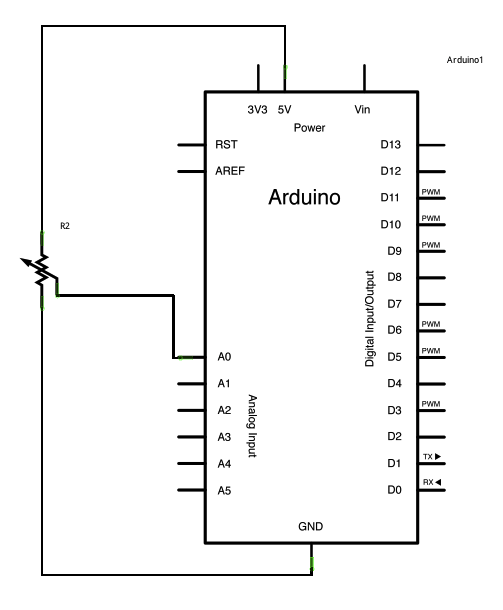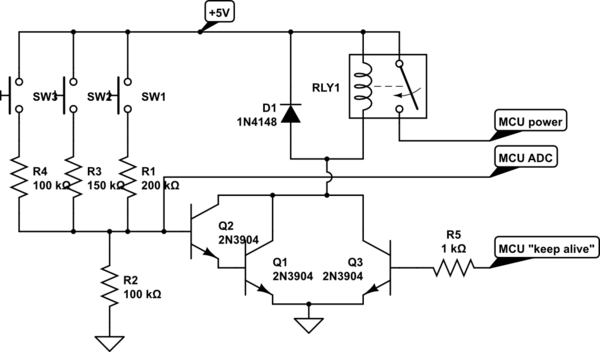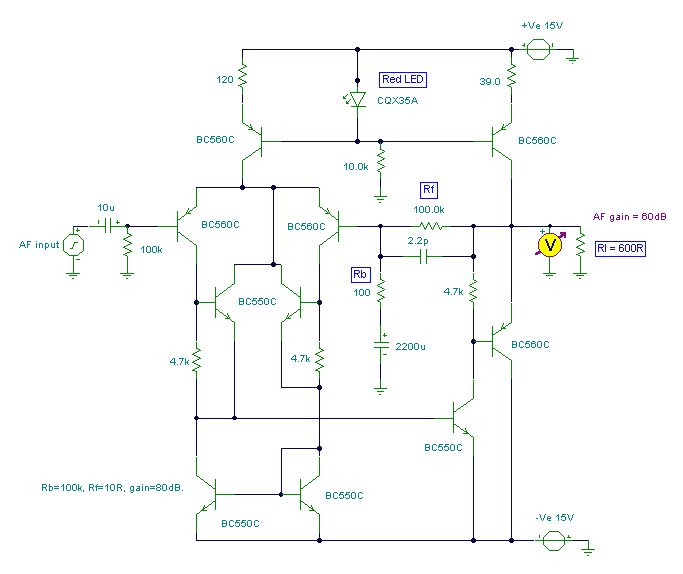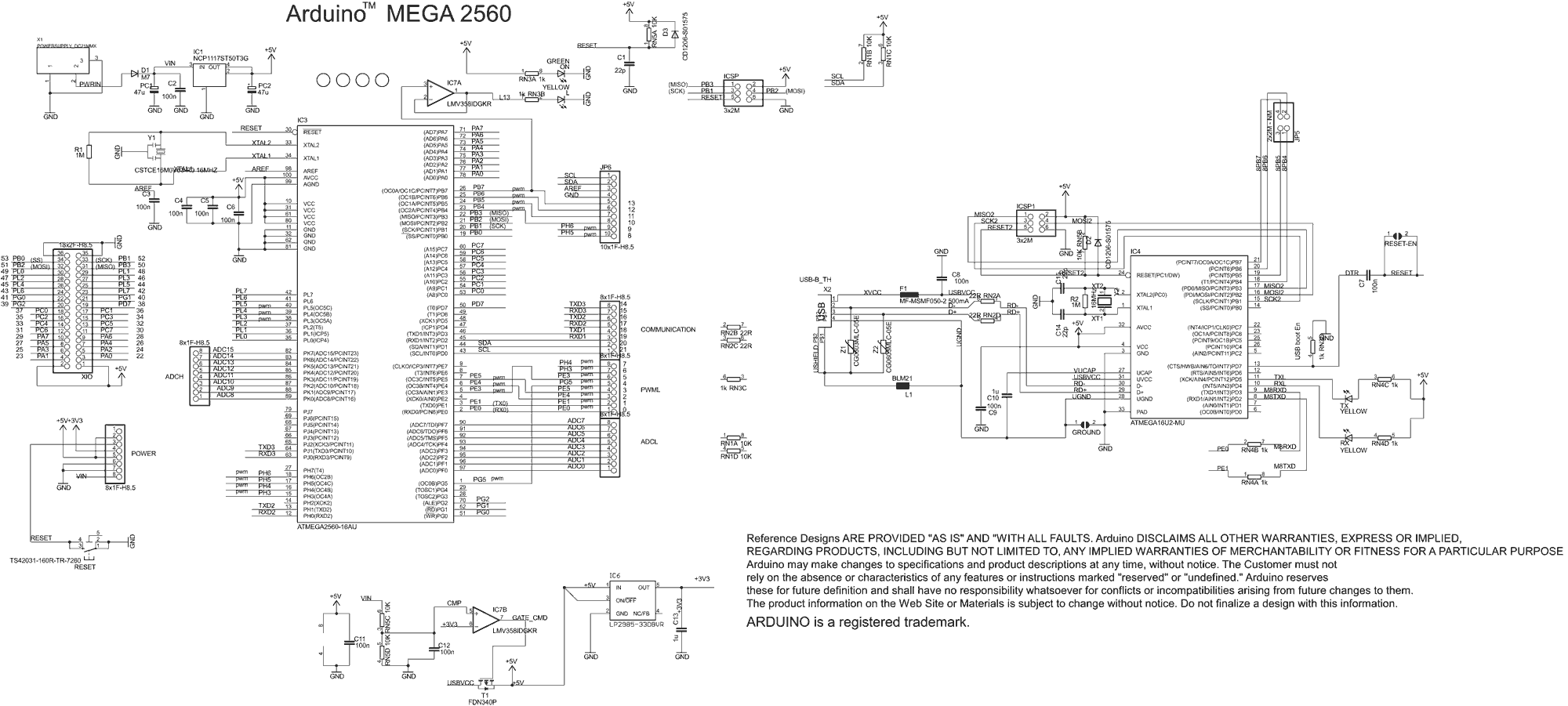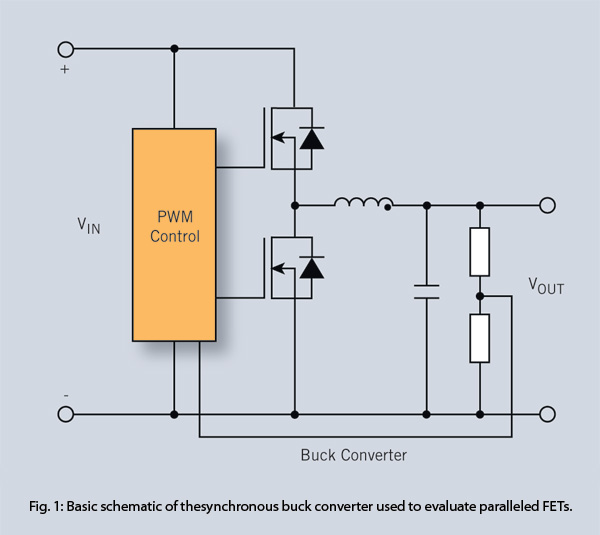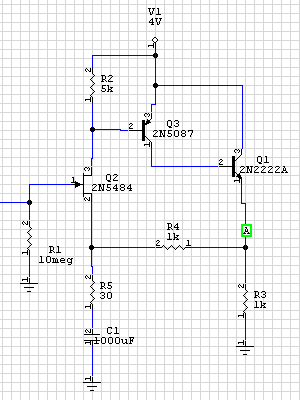
MPF102 FET Preamplifier Arduino
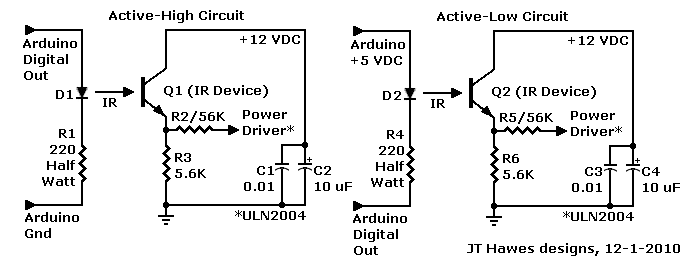
A Darlington transistor can enhance circuit performance, although it introduces slight complexity. The advantage of using a Darlington configuration lies in its capability to achieve low output impedance. The recommended component is the 2N6426 from Mouser, with alternatives such as the 2N6427 and MPSA13. Each Darlington transistor functions as an integrated circuit containing two high-gain transistors. For those opting against the 2N6426, a custom Darlington can be constructed using two 2N3904 transistors, though this combination yields a lower gain of 40,000 compared to the 2N6426's 300,000. The circuit design includes an Arduino digital output that drives an infrared LED in series with a 220-ohm half-watt resistor, ensuring safe current levels for the LED. The circuit can accommodate both active-high and active-low configurations. A 12-volt stepper supply powers a phototransistor, with its emitter connected to a 5.6K quarter-watt resistor, and a 56K quarter-watt resistor coupling the emitter signal to the Darlington array input. When the LED is activated, the phototransistor generates a high pulse for the motor drive chip. Additional components include a 0.01 µF capacitor for digital noise reduction and a 10 µF capacitor for filtering low-frequency ripple. The 56K resistor is optional and may be adjusted based on driver requirements. Alternatively, an opto-isolated array such as the Vishay 782-ILQ615-3 is suggested, which contains four opto-couplers and operates effectively with a current of 10 mA.
The circuit utilizes a Darlington transistor configuration to amplify the input signal from the Arduino, providing a robust control mechanism for motor applications. The 2N6426 is particularly advantageous due to its high current gain, which allows for significant output current with minimal input current, making it ideal for controlling larger loads such as stepper motors. The integration of a phototransistor in the circuit serves as a sensor, which detects the infrared LED's activation and generates a corresponding signal for the motor driver, ensuring precise control.
The choice of resistors in the circuit is critical for maintaining the integrity of the signals. The 220-ohm resistor protects the LED from excessive current, while the 5.6K and 56K resistors help manage the signal levels and protect the Darlington array from potential damage caused by excessive current from the phototransistor. The capacitors included in the design are essential for stability, with the 0.01 µF capacitor effectively filtering out high-frequency noise that could disrupt the operation of the microcontroller and motor driver.
In applications where space is a constraint or where multiple opto-isolators are required, the Vishay 782-ILQ615-3 provides a compact solution. This device simplifies the design by integrating multiple opto-couplers into a single package, reducing the overall component count and PCB space required.
Overall, this circuit design exemplifies a practical application of Darlington transistors and opto-isolators in control systems, ensuring reliable operation while accommodating various design considerations such as component selection and signal integrity.A Darlington would perform even better, but the circuit would be slightly more complicated. (See the schematic at bottom-right. ) Fortunately, the added complexity is inside the part! The reason for the Darlington`s superiority is that it can provide the lowest output impedance. I don`t know how low you need the output impedance to be. For the Darl ington, I strongly recommend the 2N6426 from Mouser. Similar devices are the 2N6427 and MPSA13. Each Darlington transistor is actually an IC with two super beta transistors inside. Either one of these internal devices is a superman. Together, they rule the universe. If you don`t want to try the 2N6426, you could build your own Darlington with two 2N3904 transistors from Radio Shack. Yet two 2N3904s only have a combined gain of 40K. The 2N6426 has a gain of 300K. Either version of the circuit should work, but the 2N6426 has the edge. (All that gain provides extra elbow room in the form of sensitivity. Actually, nobody uses the whole 300K. Think about it: In theory, 1 milliamp on the base gets you 300 amps on the collector. In real life, that much current would crater your PC board!) Here`s the circuit The Arduino digital output pulses an infrared LED that`s in series with a 220-ohm, half-watt resistor.
(One LED for each motor coil. ) The resistor reduces the Arduino current to a safe value for the LED. Be sure to use a half-watt resistor here. The LED could be active-high or active-low. (The drawing below shows both versions of the circuit. ) The 12-volt stepper supply powers the phototransistor. The phototransistor`s emitter is in series with a 5. 6K, quarter-watt resistor. Another resistor, 56K, quarter watt, couples the emitter signal to the Darlington array input. Whenever the LED lights, the phototransistor sends a high pulse to the motor drive chip. A 0. 01 µF capacitor shunts digital noise to ground. A parallel 10 µF capacitor filters low-frequency ripple from the phototransistor supply. The 56K resistor is optional. The purpose of this resistor is to limit current and isolate the phototransistor from the Darlington array. Tweak the value of this resistor as necessary. If your driver requires a little extra voltage, you can remove the 56K resistor. You might prefer to use an opto array instead of discrete optos. Then I suggest the Vishay 782-ILQ615-3 from Mouser. This part comes in a DIP-16 package and includes four opto-couplers. The LEDs in this package will operate adequately with only 10 mA. 🔗 External reference
The circuit utilizes a Darlington transistor configuration to amplify the input signal from the Arduino, providing a robust control mechanism for motor applications. The 2N6426 is particularly advantageous due to its high current gain, which allows for significant output current with minimal input current, making it ideal for controlling larger loads such as stepper motors. The integration of a phototransistor in the circuit serves as a sensor, which detects the infrared LED's activation and generates a corresponding signal for the motor driver, ensuring precise control.
The choice of resistors in the circuit is critical for maintaining the integrity of the signals. The 220-ohm resistor protects the LED from excessive current, while the 5.6K and 56K resistors help manage the signal levels and protect the Darlington array from potential damage caused by excessive current from the phototransistor. The capacitors included in the design are essential for stability, with the 0.01 µF capacitor effectively filtering out high-frequency noise that could disrupt the operation of the microcontroller and motor driver.
In applications where space is a constraint or where multiple opto-isolators are required, the Vishay 782-ILQ615-3 provides a compact solution. This device simplifies the design by integrating multiple opto-couplers into a single package, reducing the overall component count and PCB space required.
Overall, this circuit design exemplifies a practical application of Darlington transistors and opto-isolators in control systems, ensuring reliable operation while accommodating various design considerations such as component selection and signal integrity.A Darlington would perform even better, but the circuit would be slightly more complicated. (See the schematic at bottom-right. ) Fortunately, the added complexity is inside the part! The reason for the Darlington`s superiority is that it can provide the lowest output impedance. I don`t know how low you need the output impedance to be. For the Darl ington, I strongly recommend the 2N6426 from Mouser. Similar devices are the 2N6427 and MPSA13. Each Darlington transistor is actually an IC with two super beta transistors inside. Either one of these internal devices is a superman. Together, they rule the universe. If you don`t want to try the 2N6426, you could build your own Darlington with two 2N3904 transistors from Radio Shack. Yet two 2N3904s only have a combined gain of 40K. The 2N6426 has a gain of 300K. Either version of the circuit should work, but the 2N6426 has the edge. (All that gain provides extra elbow room in the form of sensitivity. Actually, nobody uses the whole 300K. Think about it: In theory, 1 milliamp on the base gets you 300 amps on the collector. In real life, that much current would crater your PC board!) Here`s the circuit The Arduino digital output pulses an infrared LED that`s in series with a 220-ohm, half-watt resistor.
(One LED for each motor coil. ) The resistor reduces the Arduino current to a safe value for the LED. Be sure to use a half-watt resistor here. The LED could be active-high or active-low. (The drawing below shows both versions of the circuit. ) The 12-volt stepper supply powers the phototransistor. The phototransistor`s emitter is in series with a 5. 6K, quarter-watt resistor. Another resistor, 56K, quarter watt, couples the emitter signal to the Darlington array input. Whenever the LED lights, the phototransistor sends a high pulse to the motor drive chip. A 0. 01 µF capacitor shunts digital noise to ground. A parallel 10 µF capacitor filters low-frequency ripple from the phototransistor supply. The 56K resistor is optional. The purpose of this resistor is to limit current and isolate the phototransistor from the Darlington array. Tweak the value of this resistor as necessary. If your driver requires a little extra voltage, you can remove the 56K resistor. You might prefer to use an opto array instead of discrete optos. Then I suggest the Vishay 782-ILQ615-3 from Mouser. This part comes in a DIP-16 package and includes four opto-couplers. The LEDs in this package will operate adequately with only 10 mA. 🔗 External reference
